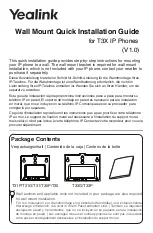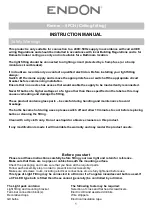
Disassembly Procedures
Remove Plunger Assembly from Handle
Grasp the head of the plunger assembly and pull it straight out from the handle.
Be careful to keep the plunger assembly clean and free from contaminants. It
is advisable to cover the plunger assembly with a clean, lint-free towel when
it is not in the handle.
Remove Handle from Vacuum Pad
Remove the 6 handle screws, and separate the handle from the pad. Carefully
remove the valve stem from the rubber nipple on the pad by gently pulling on
the handle and twisting it back and forth.
Remove Retainer and Check Valve from Handle
Being careful not to scratch the inside of the handle, remove the retainer and
check valve using a hooked scribe or similar tool. With a soft, lint-free cloth,
carefully clean these parts, as well as the plunger assembly, paying particular
attention to the U-cup and button. Wrap a small dowel or rod with a soft, lint-
free cloth and gently wipe the inside of the handle, to make sure it is clean
and dry (lubricant-free).
Assembly Procedures
Inspect Handle and Reinstall Check Valve and Retainer
Carefully examine the inside of the handle for scratches and contaminants,
using a flashlight for illumination. Scratches between the mid-point and the
closed end of the handle can cause leakage. Scratches near the open end
of the handle rarely present a problem. Make sure that no lubricant remains
inside the handle. Drop the check valve inside the handle so that it lays flat
against the closed end. Using a dowel or other tool that will not scratch the
sides of the handle, push the retainer all the way into the handle to hold the
check valve securely in place.
Attach Handle to Vacuum Pad
Apply a light coating of plunger lube to the valve stem of the handle, and insert
the valve stem into the pad nipple. Place the handle on the pad so its nipple
fits through the large hole in the base plate near the closed end of the handle.
Align the screw holes and reinstall the handle screws.
Reinsert Plunger Assembly into Handle
Apply lubricant all the way around the exposed surface of the U-cup, while
being careful to keep lubricant off the button. Plunger lube is recommended and
available in appropriate quantities by contacting Wood’s Powr-Grip Customer
Service.
Do not use improper lubricants in the handle.
While making certain the button, check valve and retainer remain free of
lubricant, insert the U-cup end of the plunger assembly into the handle. Push
the plunger assembly until it begins to tighten; then seat the plunger assembly
with one strong, swift motion. Operate the plunger to spread the lubricant,
thoroughly coating the outside of the U-cup by twisting the plunger as it moves.
Now the cup is assembled and ready for testing.






















